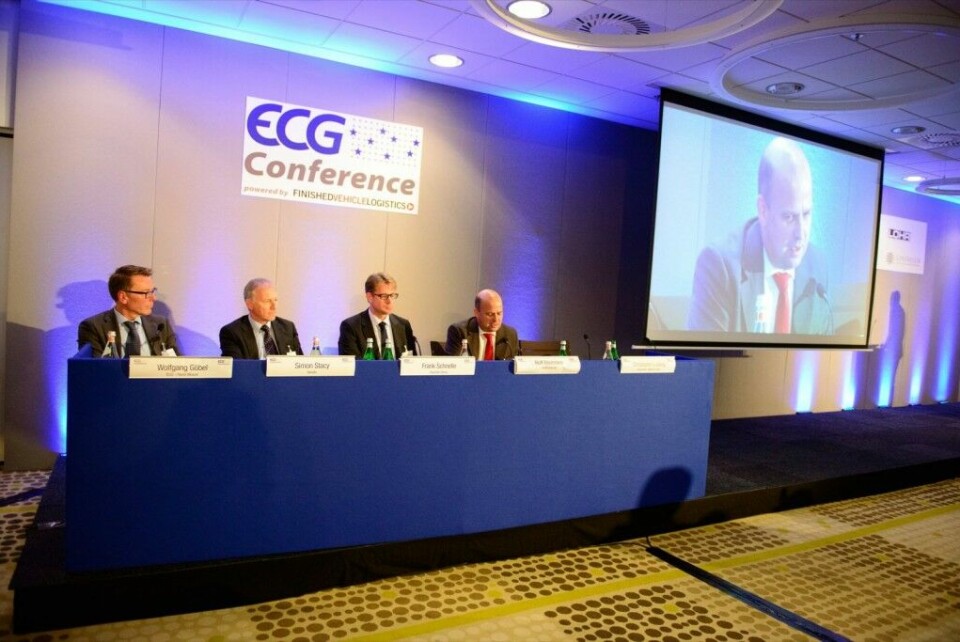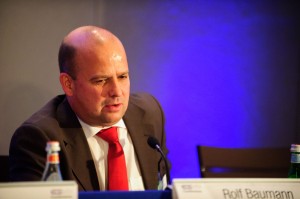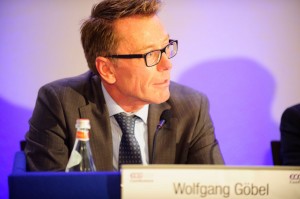ECG Conference: filling in the delivery gaps
As ECG 2014 came to an end in Amsterdam, a panel of logistics experts discussed their hopes and challenges for the future. Objectives centred around improving visibility and communication, with methods that include both technology and better relationships

Although Europe’s recovery in vehicle sales has so far been small, the Amsterdam conference left reasons to be cautiously optimistic. The industry has seen an increase of competitiveness in the region, and carmakers seem more focused than ever on delivering vehicles reliably on time to promised delivery dates. That means more focus on vehicle logistics processes, systems and strategies, whether it is centralised stock management or more flexible approaches by country. Executives also expressed an openness to working more closely with providers to make sure that contract lengths and terms are sufficient to meeting their expected levels of service.
The panel comprised Rolf Baumann, manager outbound for the Opel Group; Frank Schnelle, general manager, development and planning, Hyundai Glovis; Simon Stacy, head of car logistics, Honda Europe; and Wolfgang Göbel, vice-president ECG, and director of sales, marketing and logistics at Horst Mosolf.
...on the big changes to the finished vehicle logistics sector in Europe
Rolf Baumann, Opel: GM Europe is undergoing significant changes as a whole and has made some drastic moves within the logistics area. We are on a solid way back into the industry as a major player. Our logistics portion is tied up with Gefco on a long-term 4PL commitment. For the next five years we have to make sure we tackle challenges and tasks, and achieve them together. Each company individually needs to make sure the relationship is paying off. We have to be profitable, and for logistics we have to get the most out of the setup created one-and-a-years ago.
 Rolf Baumann said that GM Europe's logistics agreement with Gefco would be a defining part of the next five years
Rolf Baumann said that GM Europe's logistics agreement with Gefco would be a defining part of the next five years
Simon Stacy, Honda: For us one of the main tasks has been centralisation, and putting stock into limited points across Europe. The knock-on effect is on our requirements for delivery. The pressure is on logistics with lead-time delivery, and it presents problems and puts the pressure on logistics service providers.
Looking forward, fuel-cell vehicles will be coming soon. How do we manage those as a manufacturer, and how do we manage that technology on ships and trucks? Customer requirements will also be increasing, which will require an increase of traceability of the asset from our side. We need to look at improving the customer experience from what it is currently, as you receive more tracking info from a £250 ($400) appliance than you do a car.
Wolfgang Göbel, ECG/Horst Mosolf: Europe is fragmented and there are different growth scenarios. Logistic service providers have to respond to the market and market requirements. As heard from our economic experts, investment should be done in ‘winter’, so LSPs have to prepare now. There will also be new software across the whole network, and a change in distribution models. In future, will it be possible to deliver to big cities, and will automotive companies still have large distribution centres like big brands have? Every LSP is facing similar changes. From our point of view, there are many things that will change and increase the necessity for new investment.
 Glovis's Frank Schnelle said that the switch from a push to pull system at Hyundai-Kia has had big impacts for logistics
Glovis's Frank Schnelle said that the switch from a push to pull system at Hyundai-Kia has had big impacts for logistics
Baumann: If you look at our sales model internally, outbound logistics is seen as inventory, as we make revenue recognition when a car hits the dealer. By that logic, outbound logistics should be fast rather than slow: that is the view for us as a company. But the real question is about what is important for the customer. They don’t care how much inventory we hold, or whether we’re centralised or not, but that they have a delivery date, which we commit to. We measure delivery reliability, and it directly impacts the customer. We have to work closely with people involved in moving vehicles, get faster, and minimise inventory. And we still need to get this better.
Stacy: Over the past 12-18 months, we have committed to giving customers a date for delivery regardless of where the vehicle is, and have some buffers built into the predicted arrival. We have refined the process, but we are rigid and leave everything [transport related] to logistics providers like Mosolf, who have the ability to maximise efficiency. It involves working together, and how we work with LSPs.
Schnelle: It’s very important we have a delivery date, and as fast as possible. It should be available for the day of delivery, not plus or minus one. It’s a push-to-pull strategy. Planning has to start early, and not when the vehicle is on the transportation yard. You push from last mile to the previous process in order to achieve accuracy.
...on visibility gaps in the process
Baumann: There are integrity problems sometimes. In a perfect world we would commit to a date we have given to the customer, but if everyone has a buffer we will have such a long lead time that he might say, ‘If I have to wait that long I’d rather go somewhere else’. You want to be aggressive there, deliver the car faster, and commit to a date. The question is how consistent is the data flow along the chain, and how do we deal with exceptional events? If we don’t have time to catch up with the delay, we have to get into a conversation with the customer and commit to a new date. If I give him a second date, we have to hit that date, as it gets ridiculous if  Although extended delivery times at dealers would be helpful, in some regions local regulations just won't allow it, said Wolfgang Goebel
Although extended delivery times at dealers would be helpful, in some regions local regulations just won't allow it, said Wolfgang Goebel
...on delivery restrictions to dealers at night or weekends
Baumann: Dealers are 100% independent companies, making decisions on their own, including opening hours. As a logistics person, we would rather have 24/7 opening hours as this would give us an advantage. We have been successful extending opening hours in some occasions. We are in discussion in the UK about opening hours, and in other markets. However, you can’t dictate it. It’s a discussion to have with the dealers, and some are more cooperative than others.
Göbel: There are many restrictions which may lead to just a couple of more hours per day. There are urban areas you are not allowed in the daytime, certain countryside areas at night, and neighbourhoods which do not allow noise after 10pm and before 6am. We are constantly working with customers but sometimes there is no solution.
Stacy: At some larger dealers they have personnel to take deliveries at all hours, but this is not acceptable for some, with customer complaints in residential areas. You have to understand what is realistic: for the dealer, and for us supporting you. There is no solution that suits everybody. (For more on afterhour deliveries, read here)
Schnelle: There are new telematics systems that could inform dealer of potential late deliveries, which could give us more confidence going forward.
...on contract terms and getting the best from LSPs
Stacy: Each company will have its own policy relating to procurement. We have a two-year renewal policy and we tender every two years. If there can be proven benefits from a longer contract, we can take that to whomever and try to make it work, but we have to see tangible benefits.
Schnelle: We have long-term relationships with suppliers in many markets. However, situations are changing and we have to adapt, look to the market, look to new possibilities, check what’s possible and whether we’re still competitive. We don’t want to pay more than Opel or Honda is paying, and we don’t want to subsidise success. In our case, we have typically given two-year contracts for transport from the factories. But for dealer distribution, we are looking for models that might allow for more stable investment and planning, and have issued contracts that were 3-5 years long.
Baumann: We don’t have a standard contract length. We are doing a lot of three-year contracts, but some are longer. We have not found a better way than doing a tendering process, although we would be happy if we could avoid doing bids every year. However, it presents an opportunity to engineer the network, and we have found this an efficient way of doing it. Depending on the situation we are open to longer or shorter-term contracts depending on what we expect for the future.
Göbel: In a tender, sometimes you get the best out of it, and sometimes you just get money. Talking about change as a constant factor, it can be necessary to adapt the network. We will typically ask for five-year contracts when we know that specific investment is required.
 Honda's Simon Stacy said that the carmaker has been trying to bid its business on a pan-European level, but that the market was still fragmented by national providers
Honda's Simon Stacy said that the carmaker has been trying to bid its business on a pan-European level, but that the market was still fragmented by national providers
Göbel: We are strong in certain markets: in Germany, France, we have a working subsidiary in the Czech Republic, and a company with STVA in Poland, but I would not say we are a true pan-European company. There is very fragmented market development, which requires different responses that a medium-sized company like ours cannot offer at the moment.
Stacy: During our last tender, we bid across regions, rather than country by country. Country borders can be eliminated to look at synergies. We’re quite open to the idea, but the concept is more difficult to deliver, as the market is still divided by country-specific strengths. It becomes more regional, with a few countries joining together. But we are open to that.
Schnelle: There are lots of players in the market, and regional strengths, but the market is not that complex. On the other hand, maybe there are certain variants in the market preventing truly pan-European operations. When it comes to intermodal, there is no player covering all the stages. It limits the possibility to be more efficient. It is an opportunity among OEMs to fill those kinds of gaps. Desire and possibility needs to improve from our side.
Baumann: We are not fully centralised as we think the markets are different and the services required are different. We have some functions centralised but others are decentralised, and we use service providers. It would be nice to have pan-European service providers, but I’m not seeing them and it’s not the biggest obstacle.
The ECG conference is the annual industry gathering of the Association of European Vehicle Logistics. It is organised and powered by Finished Vehicle Logistics. For more on ECG, please click here.
The next Automotive Logistics conference will be South America, held November 4th in Sao Paulo, Brazil.





